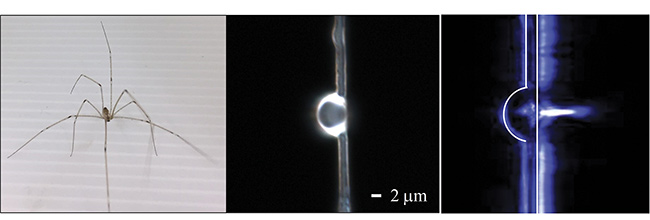It turns out that some high-level problems in biomedical imaging can be solved with “supplies” found in the basement. Actually, unused storage areas may be literally crawling with sources of these materials.
Why? Because spider silk can be used to make superior optical lenses.
Researchers at Tamkang University and National Yang-Ming University in Taiwan turned to spider silk when investigating easier, cheaper ways to develop lenses. And what isn’t more readily available than spiders — often to our dismay?
Spider silk has long been a material of interest to designers because of its high elasticity, toughness, and tensile strength. Relative to its weight, some spider silk is stronger than steel. It is also nontoxic to living tissue, an obvious plus when working with cells. The research team chose to work with Pholcus phalangioides, or daddy longlegs, because they are common in Taiwan.
What the scientists discovered, after dripping a resin onto smooth dragline silk — the strongest kind of silk a spider makes — is that the silk naturally forms the resin into a dome shape. After being cured in ultraviolet radiation, the dome becomes employable as a lens. The best part is that this phenomenon results in optimal quality imaging.
The beam produced after shining a laser through the dome lens is called a photonic nanojet (PNJ). The superior focusing capability that PNJs provide near a surface has made them popular for many biomedical nanoimaging applications, such as superresolution microscopy. The spider silk dome lenses created in the study focus more efficiently than those produced through synthetic multimaterials. The lens consists of only one material, the resin, and can be easily reshaped in the condensing process to customize the length of the photonic nanojet.
“A flexible PNJ like this is suitable for imaging the nanoscale objectives in different depths within biological tissue,” said Cheng-Yang Liu, one of the scientists on the team. “We can use a mold to cast the lens shape [into] different types.” This can result in longer or shorter photonic nanojets.
Before commercializing the lenses and thereby enhancing the performance of biomedical imaging equipment, some challenges still need to be addressed. The most notable is how to deal with out-of-plane scattering, a common phenomenon in all imaging, which reduces the intensity of a photonic nanojet. Even so, the potential for these silk lenses to deliver much-needed light has researchers caught in a web of possibilities.
So what isn’t to love about spiders?

A daddy longlegs on top of dragline silk of the type used in the study (left), a dome lens on the fiber (middle), and an example of a photonic nanojet
generated by the lens (right). Courtesy of Cheng-Yang Liu.